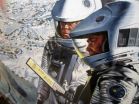(Press-News.org) PHILADELPHIA - Nearly 100 years after a British neurologist first mapped the blind spots caused by missile wounds to the brains of soldiers, Perelman School of Medicine researchers at the University of Pennsylvania have perfected his map using modern-day technology. Their results create a map of vision in the brain based upon an individual's brain structure, even for people who cannot see. Their result can, among other things, guide efforts to restore vision using a neural prosthesis that stimulates the surface of the brain. The study appears in the latest issue of Current Biology, a Cell Press journal.
Scientists frequently use a brain imaging technique called functional MRI (fMRI) to measure the seemingly unique activation map of vision on an individual's brain. This fMRI test requires staring at a flashing screen for many minutes while brain activity is measured, which is an impossibility for people blinded by eye disease. The Penn team has solved this problem by finding a common mathematical description across people of the relationship between visual function and brain anatomy.
"By measuring brain anatomy and applying an algorithm, we can now accurately predict how the visual world for an individual should be arranged on the surface of the brain," said senior author Geoffrey Aguirre, MD, PhD, assistant professor of Neurology. "We are already using this advance to study how vision loss changes the organization of the brain."
The researchers combined traditional fMRI measures of brain activity from 25 people with normal vision. They then identified a precise statistical relationship between the structure of the folds of the brain and the representation of the visual world.
"At first, it seems like the visual area of the brain has a different shape and size in every person," said co-lead author Noah Benson, PhD, post-doctoral researcher in Psychology and Neurology. "Building upon prior studies of regularities in brain anatomy, we found that these individual differences go away when examined with our mathematical template."
A World War I neurologist, Gordon Holmes, is generally credited with creating the first schematic of this relationship. "He produced a remarkably accurate map in 1918 with only the crudest of techniques," said co-lead author Omar Butt, MD/PhD candidate in the Perelman School of Medicine at Penn. "We have now locked down the details, but it's taken 100 years and a lot of technology to get it right."
The research was funded by grants from Pennsylvania State CURE fund and the National Institutes of Health (P30 EY001583, P30 NS045839-08, R01 EY020516-01A1).
###
For more information:
NC Benson, et al., The Retinotopic Organization of Striate Cortex Is Well Predicted by Surface Topology, Current Biology (2012) https://cfn.upenn.edu/aguirre/wiki/public:data_currbio_2012_benson
Penn Medicine is one of the world's leading academic medical centers, dedicated to the related missions of medical education, biomedical research, and excellence in patient care. Penn Medicine consists of the Raymond and Ruth Perelman School of Medicine at the University of Pennsylvania (founded in 1765 as the nation's first medical school) and the University of Pennsylvania Health System, which together form a $4.3 billion enterprise.
The Perelman School of Medicine is currently ranked #2 in U.S. News & World Report's survey of research-oriented medical schools. The School is consistently among the nation's top recipients of funding from the National Institutes of Health, with $479.3 million awarded in the 2011 fiscal year.
The University of Pennsylvania Health System's patient care facilities include: The Hospital of the University of Pennsylvania -- recognized as one of the nation's top 10 hospitals by U.S. News & World Report; Penn Presbyterian Medical Center; and Pennsylvania Hospital – the nation's first hospital, founded in 1751. Penn Medicine also includes additional patient care facilities and services throughout the Philadelphia region.
Penn Medicine is committed to improving lives and health through a variety of community-based programs and activities. In fiscal year 2011, Penn Medicine provided $854 million to benefit our community.
Penn researchers create a universal map of vision in the human brain
New technology confirms 'timeless' diagram drafted by WW1 neurologist
2012-10-04
ELSE PRESS RELEASES FROM THIS DATE:
Better battlefield triage, transport may raise severely wounded soldiers' survival rates
2012-10-04
CHICAGO—Wounded soldiers who sustained chest injuries in Operation Enduring Freedom (Afghanistan) and Operation Iraqi Freedom (Iraq) had higher mortality rates than soldiers
in Korea and Vietnam, according to a military trauma study presented at the 2012 American College of Surgeons Annual Clinical Congress. However, better battlefield triage and transport may have meant that severely wounded soldiers whom would have been considered killed in
action in previous conflicts are more likely to get sent to trauma centers in the United States sooner in their course of care, ...
Chewing ability linked to reduced dementia risk
2012-10-04
Can you bite into an apple? If so, you are more likely to maintain mental abilities, according to new research from Karolinska Institutet in Sweden.
The population is ageing, and the older we become the more likely it is that we risk deterioration of our cognitive functions, such as memory, decision-making and problem solving. Research indicates several possible contributors to these changes, with several studies demonstrating an association between not having teeth and loss of cognitive function and a higher risk of dementia.
One reason for this could be that few ...
No evidence for 30-nm chromatin fibers in the mouse genome
2012-10-04
HEIDELBERG, 4 October 2012 – Scientists in Canada and the United States have used three-dimensional imaging techniques to settle a long-standing debate about how DNA and structural proteins are packaged into chromatin fibres. The researchers, whose findings are published in EMBO reports, reveal that the mouse genome consists of 10-nm chromatin fibres but did not find evidence for the wider 30-nm fibres that were previously thought to be important components of the DNA architecture.
"DNA is an exceptionally long molecule that can reach several metres in length. This means ...
New gene test detects early mouth cancer risk
2012-10-04
Researchers from Queen Mary, University of London have developed a new gene test that can detect pre-cancerous cells in patients with benign-looking mouth lesions. The test could potentially allow at-risk patients to receive earlier treatment, significantly improving their chance of survival.
The study, published online in the International Journal of Cancer, showed that the quantitative Malignancy Index Diagnostic System (qMIDS) test had a cancer detection rate of 91-94 per cent when used on more than 350 head and neck tissue specimens from 299 patients in the UK and ...
Top executives' team spirit affects whole business
2012-10-04
Los Angeles, CA(04 October, 2012) Effective teamwork among an organization's top management makes employees happier and more productive, with positive benefits to the organization.
Despite an abundance of research on teamwork in the workplace, studies of how teamwork right at the top impacts employees lower down the food chain is surprisingly thin on the ground. Now researchers have surveyed business theory and put it to the test empirically, showing that top management's behaviour does trickle down. This new research is published by SAGE in the journal Human Relations.
Does ...
Olympic legacy: Tackling the 'East London Diabetes Belt' is a major challenge
2012-10-04
A study by Queen Mary, University of London researchers has shown the scale of the challenge facing those in charge of delivering the Olympic legacy. In three London boroughs they have found that, overall, as many as one in ten of the local population has a high risk of developing type 2 diabetes within the next ten years. In some areas close to the Stratford Olympic Park up to one in six adults are at high risk.
The study, published in the British Journal of General Practice [1], analysed half a million electronic records for all people without diabetes, aged between ...
Strathclyde take the lead in space research
2012-10-04
Academics at the University of Strathclyde in Glasgow are set to investigate the removal of space debris and deflection of asteroids – leading the first research-based training network of its kind in the world.
The 'Stardust' project will train the next generation of scientists, engineers and policy-makers with Strathclyde leading 14 partners across Europe in a new €4 million programme.
The European Commission-funded network will launch early next year and its pioneering research will have a significant impact on the future decisions of Europe on some of the most pressing ...
Science fiction is not put to good use in teaching
2012-10-04
A study at the University of Valencia ensures that science fiction, especially the cinema, is very popular amongst secondary school students and teachers see it as a good way of motivating interest in the sciences. However, out of the 31 textbooks analysed, only nine make some form of reference to science fiction cinema as a teaching resource.
"A current concern is that students are no longer studying science and engineering and this trend is more common amongst females. Science fiction can be useful in awaking the scientific vocation of younger students," as explained ...
Hi-fi single photons
2012-10-04
Many quantum technologies—such as cryptography, quantum computing and quantum networks—hinge on the use of single photons. While she was at the Kastler Brossel Laboratory (affiliated with the Pierre and Marie Curie University, École Normale Supérieure and CNRS) in Paris, France, Virginia d'Auria and her colleagues identified the extent to which photon detector characteristics shape the preparation of a photon source designed to reliably generate single photons. In a paper about to be published in EPJ D, the French team determined the value of key source parameters that ...
Lakes react differently to warmer climate
2012-10-04
The study in question has been carried out by a group of researchers at the Department of Biology at Lund University. The research team is specifically focusing on predictions regarding how our water resources will be like in the future, in terms of drinking water, recreation, fishing and biodiversity. They have now published findings on the impact of a warmer climate on lakes in the journal Nature Climate Change.
"The most interesting and unexpected result from the study is that the reaction to climate change will vary between lakes; this has been observed previously ...
LAST 30 PRESS RELEASES:
NTP-enhanced lattice oxygen activation in Ce-Co catalysts for low-temperature soot combustion
Synergistic interface engineering in Cu-Zn-Ce catalysts for efficient CO2 hydrogenation to methanol
COVID-19 leaves a lasting mark on the human brain
Scientists use ultrasound to soften and treat cancer tumors without damaging healthy tissue
Community swimming program for Black youth boosts skills, sense of belonging, study finds
Specific depressive symptoms in midlife linked to increased dementia risk
An ‘illuminating’ design sheds light on cholesterol
Who is more likely to get long COVID?
Study showcases resilience and rapid growth of “living rocks”
Naval Research Lab diver earns Office of Naval Research 2025 Sailor of the Year
New Mayo-led study establishes practical definition for rapidly progressive dementia
Fossil fuel industry’s “climate false solutions” reinforce its power and aggravate environmental injustice
Researchers reveal bias in a widely used measure of algorithm performance
Alcohol causes cancer. A study from IOCB Prague confirms damage to DNA and shows how cells defend against it
Hidden viruses in wastewater treatment may shape public health risks, study finds
Unlock the power of nature: how biomass can transform climate mitigation
Biochar reshapes hidden soil microbes that capture carbon dioxide in farmland
Reducing saturated fat intake shows mortality benefit, but only in high-risk individuals
Manta rays create mobile ecosystems, study finds
Study: Mixed results in using lipoic acid to treat progressive multiple sclerosis
Norbert Holtkamp appointed director of Fermi National Accelerator Laboratory
New agentic AI platform accelerates advanced optics design
Biologists discover neurons use physical signals — not electricity — to stabilize communication
Researchers discover that a hormone can access the brain by hitchhiking
University of Oklahoma researcher awarded funding to pursue AI-powered material design
Exploring how the visual system recovers following injury
Support for parents with infants at pediatric check-ups leads to better reading and math skills in elementary school
Kids’ behavioral health is a growing share of family health costs
Day & night: Cancer disrupts the brain’s natural rhythm
COVID-19 vaccination significantly reduces risk to pregnant women and baby
[Press-News.org] Penn researchers create a universal map of vision in the human brainNew technology confirms 'timeless' diagram drafted by WW1 neurologist


